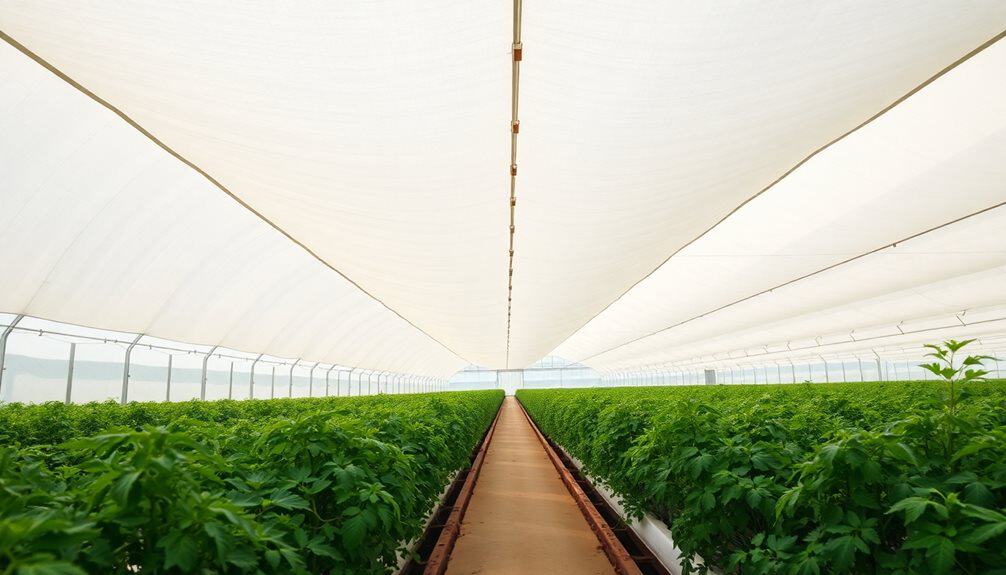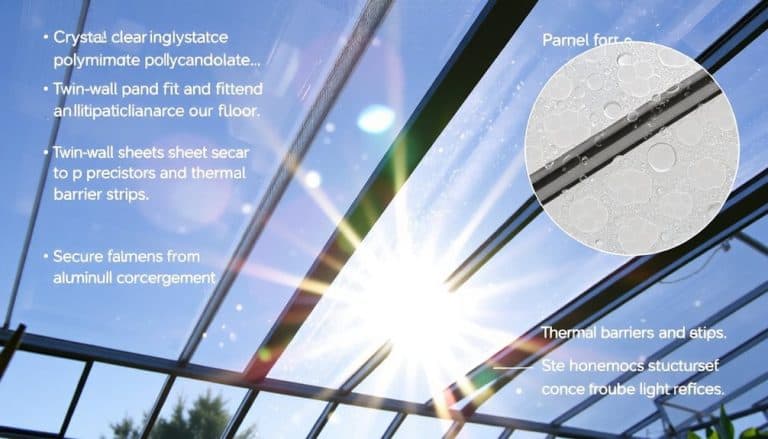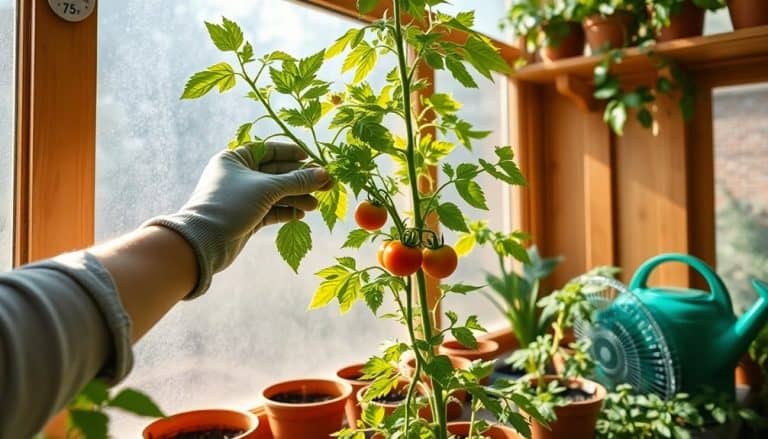This website contains affiliate links. Some products are gifted by the brand to test. As an Amazon Associate, I earn from qualifying purchases. The content on this website was created with the help of AI.
For professional greenhouse operations in 2024, you’ll achieve ideal results with aluminum-coated screens or UV-stabilized polypropylene knitted shade cloths. These materials offer 40-85% solar radiation reflection and can reduce internal temperatures by 15-20°F, while maintaining essential light transmission rates of 50-70%. You’ll see ROI within 12-18 months through 20-30% cooling cost reductions and 15-25% less crop loss. Consider your climate zone and crop requirements when selecting between 30-90% shade factors. The right choice depends on your specific operational metrics, energy efficiency goals, and long-term sustainability targets.
Key Takeaways
- Aluminum-coated screens offer superior heat reduction of 15-20°F while maintaining optimal light transmission for professional greenhouse operations.
- HDPE knitted shade cloths provide the longest lifespan (8-10 years) with 30-90% shade factors for versatile growing conditions.
- Multi-layered systems combining aluminum strips with evaporative cooling deliver maximum temperature control and energy efficiency.
- Professional installations require support cables every 6-8 feet with 200-250 pounds tension for optimal performance and durability.
- White shade cloths maintain 50-70% light transmission while effectively diffusing light, making them ideal for year-round growing operations.
Types of Greenhouse Shade Materials
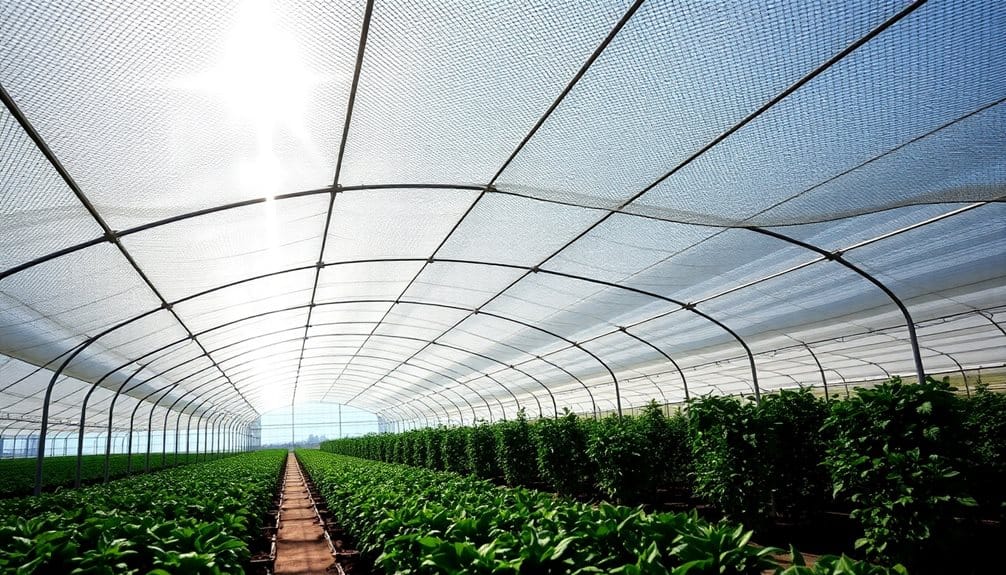
Greenhouse growers can choose from several distinct categories of shade materials, each offering specific light-diffusing properties and levels of protection. The primary types include polypropylene knitted shade cloth (30-90% shade factors), aluminum-coated screens (40-85% reflection rates), and polyethylene woven fabrics (20-70% light diffusion).
You’ll find that knitted shade cloths provide excellent durability and airflow, with UV-stabilized materials lasting 7-10 years under normal conditions. These cloths typically reduce temperature by 10-15°F while maintaining ideal light transmission for plant growth.
Aluminum-coated screens offer superior heat reduction capabilities, reflecting up to 85% of solar radiation while reducing internal temperatures by 15-20°F. They’re particularly effective for high-light environments and can cut energy costs by 20-30%.
Polyethylene woven fabrics present a cost-effective solution with shade percentages ranging from 20-70%. They’re lightweight (typically 3.5-5.0 oz/yd²), making them easier to install and remove. While they have a shorter lifespan of 3-5 years, they provide uniform light diffusion and can be combined with other materials for customized environmental control.
Light Transmission Performance
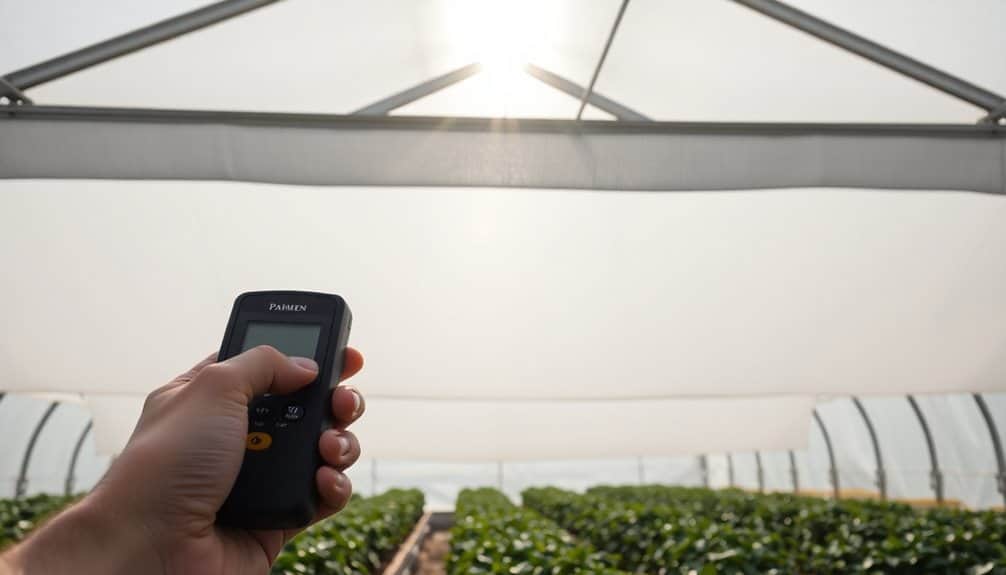
Light transmission performance directly impacts plant growth rates, making it critical to understand how different shade materials affect photosynthetically active radiation (PAR). When you’re selecting shade cloth, you’ll need to take into account both the percentage of light transmission and the wavelength specificity of the material.
Modern shade materials offer transmission rates ranging from 15% to 90%, with precision-engineered options that can filter specific light wavelengths. You’ll find that white shade cloths typically diffuse light while maintaining 50-70% transmission, while black materials provide uniform shading at 30-60% transmission rates. Aluminized materials reflect 60-85% of infrared radiation while allowing beneficial PAR wavelengths to pass through.
To enhance your growing environment, you’ll want to measure PAR levels using a quantum sensor at various times throughout the day. Target levels should maintain 400-700 nanometers for most crops. You can adjust shade percentages seasonally – using heavier shading (30-40% transmission) during peak summer months and lighter options (60-80% transmission) during shoulder seasons. This dynamic approach guarantees your plants receive ideal light levels year-round while preventing heat stress and photoinhibition.
Heat Management Solutions
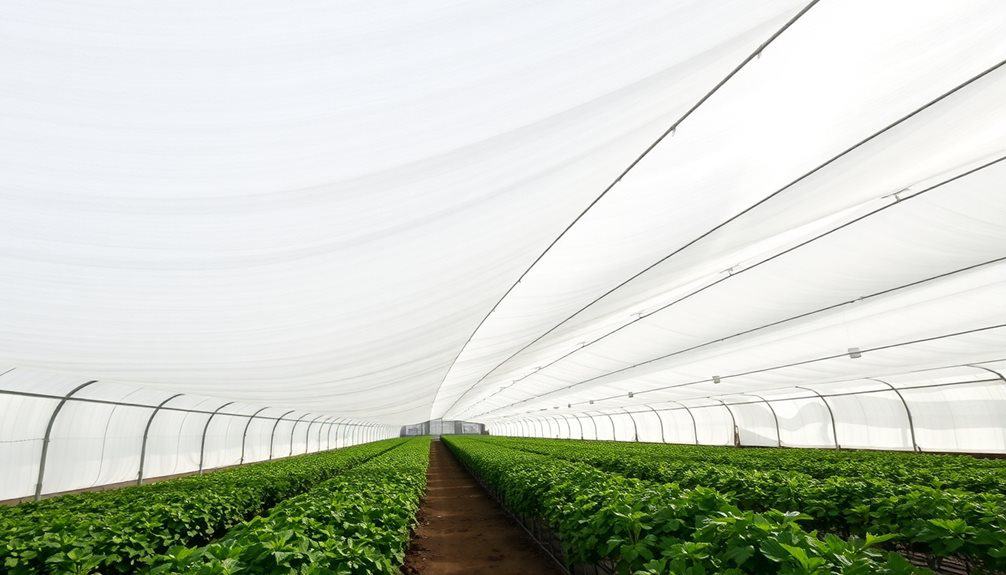
In commercial growing operations, effective heat management requires a multi-layered approach using shade cloths strategically. You’ll need to monitor temperature differentials between interior and exterior spaces while maintaining ideal growing conditions through automated control systems.
To maximize heat management efficiency, you’ll want to deploy shade cloths with thermal ratings between 30-70%, depending on your climate zone and crop requirements. The latest ceramide-infused materials can reduce heat buildup by up to 15°F compared to standard polyethylene cloths. You can integrate these with automated retraction systems that respond to real-time temperature and light sensors.
For peak summer conditions, you’ll benefit from combining shade cloths with evaporative cooling systems. Modern shade materials featuring reflective aluminum strips can deflect up to 80% of infrared radiation while allowing necessary PAR light transmission. You’ll achieve excellent results by installing various density cloths in zones – using 60% shade ratings for south-facing sections and 40% for northern exposures. During shoulder seasons, you can program your system to deploy shade cloths only when temperatures exceed crop-specific thresholds, typically between 78-85°F.
Cost Analysis and ROI

Determining the return on investment for greenhouse shade systems requires careful analysis of upfront costs against long-term operational savings. You’ll need to factor in initial material costs ($2-8 per square foot), installation expenses ($1-3 per square foot), and ongoing maintenance requirements ($0.25-0.50 per square foot annually).
The ROI calculation should include quantifiable benefits such as reduced cooling costs (20-30% savings), improved crop quality (15-25% less product loss), and extended growing seasons (30-45 additional production days). You’ll typically see energy savings of $0.50-1.00 per square foot annually through decreased HVAC usage and optimized temperature control.
Modern shade systems last 7-10 years with proper maintenance, allowing you to amortize costs over an extended period. Your payback period will vary based on climate zone and crop type, but most operations achieve ROI within 2-3 growing seasons. Track metrics like temperature differential, energy consumption, and crop yield to validate your investment. Consider automated systems, which though costlier upfront ($5-10 per square foot), can reduce labor costs by 40-60% and provide more precise environmental control.
Double-wall polycarbonate panels offer superior insulation and heat retention, making them an ideal choice for maximizing energy efficiency in professional greenhouse operations.
Climate Zone Recommendations

Selecting the ideal shade cloth percentage depends heavily on your specific climate zone and seasonal patterns. For USDA zones 9-11, you’ll need 60-70% shade cloth during peak summer months to maintain suitable growing temperatures below 85°F. In these hot climates, consider using double-layered systems with 30% + 40% overlapping cloths for adjustable coverage.
For zones 6-8, implement 30-50% shade cloth from late spring through early fall, adjusting based on your specific microclimate and crop requirements. You’ll want to remove shade cloths entirely during winter months to maximize light penetration when solar radiation is limited.
In zones 3-5, utilize 30% shade cloth only during peak summer hours (10 AM – 4 PM) to prevent leaf burn while maintaining adequate light levels for growth. Install retractable systems to quickly adapt to rapidly changing weather conditions. For coastal zones with high humidity, select knitted shade cloths with 40-50% density to balance temperature control with proper airflow and moisture management. Match your shade percentage to your latitude: higher latitudes typically require lower shade percentages to compensate for naturally reduced light intensity.
Installation and Maintenance Requirements
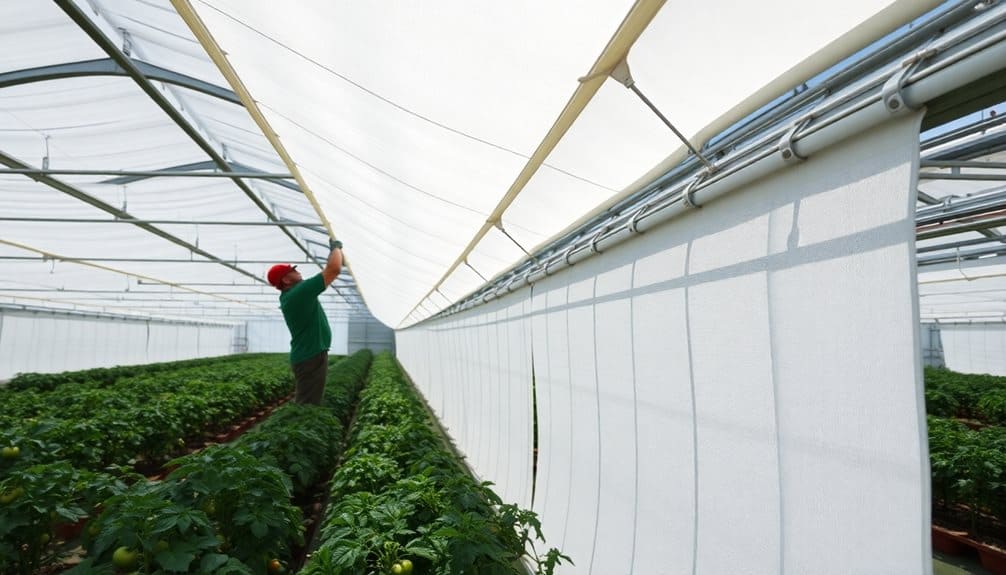
Proper installation of greenhouse shade cloths begins with securing sturdy support cables at 6-8 foot intervals across your structure’s framework. You’ll need to tension these cables to 200-250 pounds of pressure using turnbuckles, ensuring they’re parallel and level. Install aluminum shade cloth fasteners every 24 inches along these cables.
When mounting the shade cloth, you’ll want to maintain 15-20% slack to accommodate wind load and thermal expansion. Secure the material using UV-resistant zip ties rated at 50 pounds minimum breaking strength, spacing them 12 inches apart. For peak durability, install reinforced grommets at stress points and corners.
Maintenance requires monthly inspections of attachment points and tension levels. You’ll need to clean the shade cloth twice annually using low-pressure water (under 100 PSI) and a mild detergent solution (pH 6-8). Check for tears or wear spots during each cleaning session. Replace damaged fasteners immediately and re-tension support cables when they show more than 2 inches of deflection. During winter storage, fold the cloth carefully along original creases and store in a dry, rodent-free environment below 80°F.
Durability and Lifespan Expectations
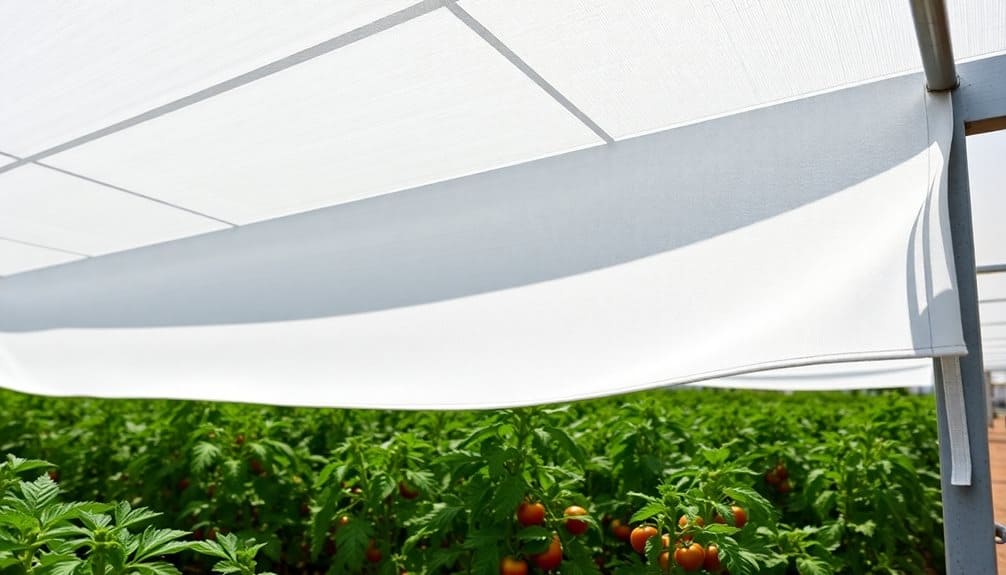
The lifespan of greenhouse shade cloths depends heavily on their material composition and environmental exposure factors. High-quality polyethylene shade cloths typically last 5-7 years, while premium knitted HDPE materials can extend to 8-10 years under ideal conditions. You’ll find that aluminum-coated materials often reach the upper end of this range due to their enhanced UV resistance.
Environmental stressors will impact your shade cloth’s durability. Direct UV exposure can reduce lifespan by 20-30%, while areas with high wind loads may experience accelerated wear at connection points. You’ll need to factor in your climate zone – growers in regions with intense sun exposure often report 30% shorter lifespans than those in moderate climates.
To maximize durability, you’ll want to maintain proper tension across the material and inspect attachment points quarterly. Data shows that properly tensioned shade cloths last 40% longer than loosely installed ones. You can expect premium shade materials to retain their original light transmission values within 5% for the first 3-4 years, with a gradual decline of 2-3% annually thereafter.
Energy Efficiency Comparisons

Consistently, shade cloths prove to be significant energy-saving investments for greenhouse operations, reducing cooling costs by 15-30% during peak summer months. You’ll find that 50% shade cloths deliver ideal energy efficiency for most crops, reducing internal temperatures by up to 10°F while maintaining essential light levels for photosynthesis.
When you’re comparing energy efficiency metrics, aluminum-based reflective cloths outperform traditional black mesh by reflecting 85% of solar radiation versus 70%. White shade cloths offer a middle ground, reflecting 75% while diffusing light more effectively. You’ll need to take into account that each 10% increase in shade percentage typically results in a 1.5°F temperature reduction.
For maximum energy savings, you’ll want to bear in mind that external shade cloth installations are 35% more effective at heat reduction than internal systems. Modern thermal screens with aluminum strips woven into polyester mesh can reduce nighttime heat loss by 20-40%, offering year-round energy benefits. By monitoring your greenhouse’s temperature differential between shaded and unshaded zones, you can calculate precise ROI metrics, typically achieving full cost recovery within 12-18 months through reduced cooling expenses.
Environmental Impact Assessment
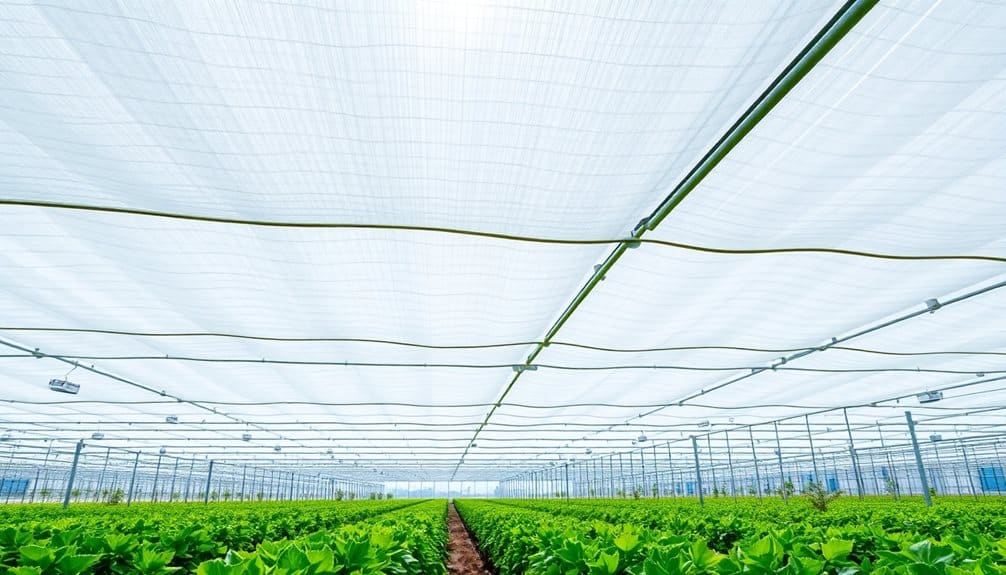
Modern greenhouse shade cloths have measurable environmental impacts you’ll need to examine. When evaluating these impacts, focus on three key metrics: carbon footprint during manufacturing, degradation characteristics, and recycling potential.
Your shade cloth’s manufacturing footprint varies considerably by material. Polyethylene-based cloths generate 2.1kg CO2 per square meter during production, while aluminum-based products produce 3.4kg CO2. You’ll find that newer bio-based materials average just 1.3kg CO2, offering a 38% reduction in manufacturing emissions.
The degradation timeline affects your environmental planning. Standard polyethylene cloths decompose in 15-20 years, releasing microplastics. You’re better off with newer composite materials that break down into non-toxic components within 8-10 years. When selecting recycling options, you’ll achieve 85% material recovery with aluminum-based cloths, compared to 60% for traditional synthetics.
You can minimize environmental impact by choosing shade cloths with certified eco-friendly dyes, which reduce water pollution by 40% compared to standard dyes. Track your cloth’s end-of-life disposal through manufacturer recycling programs, which now accept 75% of commercial greenhouse materials.
Frequently Asked Questions
Can Shade Cloths Be Used for Outdoor Garden Structures Besides Greenhouses?
You’ll find shade cloths highly versatile for multiple outdoor structures, including pergolas, gazebos, and arbors. They’re effective for creating shaded seating areas, protecting outdoor nurseries, and covering pool areas. By selecting the appropriate UV protection rating and density percentage (30-90%), you can customize light filtration for your specific needs. Install them over patios, decks, and children’s play areas for reliable sun protection during peak hours.
Will Shade Cloth Colors Affect Plant Growth Patterns Differently?
Yes, shade cloth colors will considerably impact your plants’ growth patterns. Red cloths enhance stem elongation and flowering, while blue promotes compact growth and leaf development. Black and grey cloths provide neutral shading without spectral modification. White cloths reflect more light while still reducing intensity. You’ll find green cloths least effective as they block essential red wavelengths needed for photosynthesis and plant development.
Are There Special Cleaning Products Recommended for Maintaining Shade Cloth Effectiveness?
Like giving your workhorse a proper bath, your shade cloth needs specific care to keep performing at its peak. You’ll want to use mild, phosphate-free detergents with a pH between 6-8. Commercial products like Shade Cloth Cleaner Pro or greenhouse-specific sanitizers are ideal. Don’t use bleach or harsh chemicals as they’ll break down the UV-resistant properties. Apply cleaners with a soft-bristled brush or low-pressure washer, working from top to bottom.
How Do Shade Cloths Impact Greenhouse Ventilation and Air Circulation?
Shade cloths will affect your greenhouse’s airflow by reducing natural ventilation rates by 15-40%, depending on the material’s weave density. You’ll need to adjust your ventilation system to compensate for this reduction. Tighter weaves (>70% shade) create more air resistance, while looser weaves (<40% shade) allow better circulation. Position your fans strategically and maintain adequate spacing between cloth panels to optimize air movement throughout your growing space.
Can Shade Cloths Be Customized With Company Logos or Branding?
Yes, you can customize greenhouse shade cloths with company logos and branding through several manufacturing processes. Digital printing offers high-resolution designs up to 1200 dpi, while heat transfer and screen printing work well for simpler logos. You’ll need to meet minimum order quantities (typically 500+ square feet) and select UV-resistant inks that won’t fade. Custom branding costs 15-30% more than standard shade cloth pricing.

